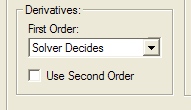Derivative Computation |
The Derivatives box on the Nonlinear Solver tab:

controls how derivatives are used in the nonlinear solver. There are two settings available: First Order and Use Second Order.
The First Order option determines how the nonlinear solver computes first order derivatives. There are two general methods available: numerical or analytical derivatives. Analytical derivatives are computed directly by symbolically analyzing the arithmetic operations in a constraint. Numerical derivatives are computed using finite differences. There are two types of numerical derivatives available using either central differences or forward differences. There are also two types of analytical derivatives available: backward analytical and forward analytical. Finally, a Solver Decides option is also available. LINGO defaults to the Solver Decides setting for the First Order option, which presently involves LINGO using backward analytical derivatives. However, one of the other choices may be more appropriate for certain classes on nonlinear models. We suggest you try the various derivative options to see which works best for your particular models.
The Use Second Order option determines if the nonlinear solver will use second order derivatives. If used, second order derivatives will always be computed analytically. Computing second order derivatives will take more time, but the additional information they provide may lead to faster runtimes and/or more accurate solutions. LINGO defaults to not using second order derivatives.
.
